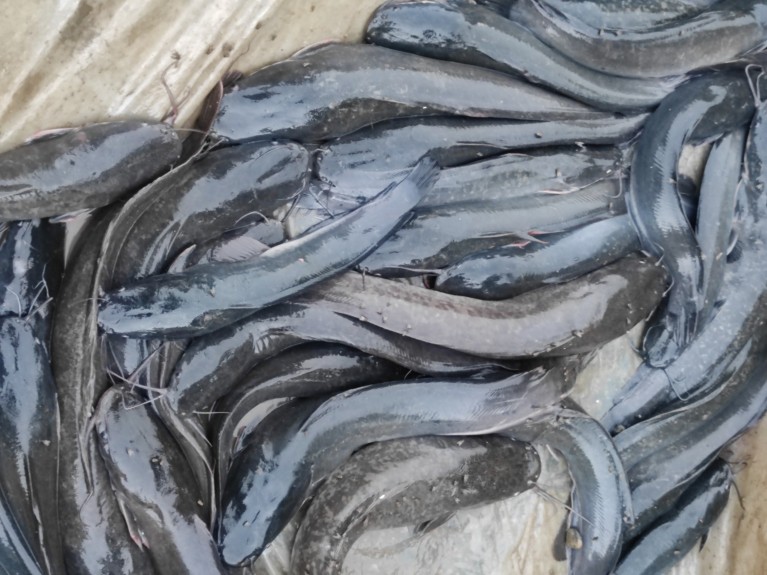CSIR - Centre for Cellular & Molecular Biology
Council of Scientific and Industrial Research
The Innovation Engine of India
Date : August 22, 2024

When molecular biologist Govindhaswamy Umapathy and his team started looking for traces of a variety of invasive catfish in 12 lakes in and around Hyderabad city in India, little did they expect the genetic material of these fish to show up in almost all samples.
“We found the environmental DNA (eDNA) of the African sharptooth catfish even in places where it wasn’t known to have invaded, like in a pond inside the city zoo,” says Umapathy.
The African catfish (Clarias gariepinus) was introduced to east India from Bangladesh in the early 1990s as a source of food. Its breeding and import are now banned by India’s agriculture ministry because it harms aquatic biodiversity. These hardy fishes thrive in polluted water and feed on native fish. However, they continue to be reared clandestinely across the country because of their low-cost meat. These fish frequently escape unregulated aquaculture farms and enter waterbodies.
To trace their eDNA, a non-invasive alternative to traditional visual surveys, the scientists tested an eDNA assay in waterbodies of Hyderabad. They found that 11 of the 12 samples showed the catfish’s presence.
The African catfish is a case in point. Patchy enforcement of regulations, lack of legal oversight or crosstalk between government agencies, limited documentation of impacts and low public awareness hinder efforts to check such invasive alien species (IAS) in India.
A recent report by the Intergovernmental Science Policy Platform on Biodiversity and Ecosystem Services (IPBES) said only 17% countries have national legislation specific to the control and management of IAS. India is among the countries that don’t, despite specific targets related to IAS mandated in its National Biodiversity Action Plan.
Plant ecologist Ankila Hiremath, a co-author of the IPBES report says there’s been a piecemeal approach to tackling IAS in India. She says none of the existing regulations were originally drafted to address IAS. Another author of the report Sankaran Kavileveettil points to the Plant Quarantine (PQ) Order 2003 and its amendments that talk of such species but categorise them as quarantine pests.
Current control measures are focused on just a few well-known invasive species and in specific habitats, such as interventions by forest managers to curb the spread of the perennially flowering invasive lantana species’ spread in protected areas.
Biosecurity checks at international and domestic borders have failed to step up to growing global trade as well as e-trade, and travel, says Sankaran. “Nobody checks whether plant and animal material is being brought in at airports,” adds Hiremath.
Sankaran says private agribusinesses import seeds and nursery plants disregarding phytosanitary measures.
India’s plant biosecurity legislations (Destructive Insects and Pests Act, 1914 and Plant Quarantine Order, 2003) mainly cover the agriculture sector. “We need to have regulations exclusive to forestry, not embedded in agricultural regulations,” says Sankaran.
 Advertisement no 07/10 for the post Junior Scientist.
Advertisement no 07/10 for the post Junior Scientist.
 List of shortlisted candidates for the temporary positions against CCMB Web Notif.No.0724/B- [26-08-2024]
List of shortlisted candidates for the temporary positions against CCMB Web Notif.No.0724/B- [26-08-2024]
 Result of selected candidates for the temporary positions against CCMB Web Notif.No.0724/A - [21-08-2024]
Result of selected candidates for the temporary positions against CCMB Web Notif.No.0724/A - [21-08-2024]
 Notification of Schedule for Trade Test and Downloading of Admit Cards for the posts of Gr. II (1)/Technician (1) against Advt.No:01/2021 - [19-08-2024]
Notification of Schedule for Trade Test and Downloading of Admit Cards for the posts of Gr. II (1)/Technician (1) against Advt.No:01/2021 - [19-08-2024]
 List of selected candidates for the temporary positions against CCMB Web Notif.No.0624/A - [14-08-2024]
List of selected candidates for the temporary positions against CCMB Web Notif.No.0624/A - [14-08-2024]
 List of shortlisted candidates for the temporary positions against CCMB Web Notif.No.0724/A - [02-08-2024]
List of shortlisted candidates for the temporary positions against CCMB Web Notif.No.0724/A - [02-08-2024]
 Notification No.0824/A for various temporary positions on contractual basis- [02-08-2024]
Notification No.0824/A for various temporary positions on contractual basis- [02-08-2024]
 Notification No.0724/B for various temporary positions on contractual basis - [29-07-2024]
Notification No.0724/B for various temporary positions on contractual basis - [29-07-2024]
 List of shortlisted candidates for the temporary positions against CCMB Web Notif.No.0624/A- [19-07-2024]
List of shortlisted candidates for the temporary positions against CCMB Web Notif.No.0624/A- [19-07-2024]
 List of Provisionally empanelled candidates for Engagement as Project staff Vide Notif.No.2024/1 - [15-07-2024]
List of Provisionally empanelled candidates for Engagement as Project staff Vide Notif.No.2024/1 - [15-07-2024]